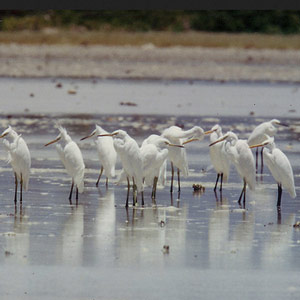Magazine | Voyages
Observer les oiseaux sur l’île de Cebu (Philippines)

Aigrettes de Chine (Egretta eulophotes) dans le Olango Wildlife Sanctuary, tout près de l’île de Cebu (Philippines).
Photographie : Drakesketchit / Wikimedia Commons
Introduction
Les Philippines sont constituées de près de 7 100 îles s’étendant entre l’Indonésie au sud et Taïwan au nord. L’avifaune de cet archipel possède l’un des plus forts degrés d’endémisme dans le monde, avec quelques 172 espèces, plus huit autres à distribution limitée. Les Visayas regroupent le plus grand nombre d’îles : le complexe Negros, Panay à l’ouest, Cebu au centre, et à l’est Bohol, Samar et Leyte.
La dégradation écologique de cette région est extrême, la déforestation étant quasi-totale. Les oiseaux endémiques se réfugient alors dans les petits lambeaux restants. Avec près de 99,7% de sa couverture originale forestière détruite, Cebu est sûrement la plus touchée : la moitié des espèces forestières (près de 40 espèces) y ont disparu, dont quelques sous-espèces endémiques. Il reste deux endémiques sur l’île, le Dicée quadricolore (Dicaeum quadricolor) et le Shama de Cebu (Copsychus cebuensis). On a cru que toutes deux étaient éteintes, mais la première a été redécouverte en 1993, et le shama en 1981.
Nous vous proposons dans cet article une présentation des principaux sites ornithologiques de Cebu. Les photos ont été réalisées par Francis Cauet (Digiplumes.com), qui a visité l’île en février 2006.
Abstract
The Philippines is a 7,100 islands archipelago lying between the Malayan-Indonesian complex and Taiwan. Geography and evolution have left one of the highest degrees of endemism of the world with some 172 endemic species of birds. The Visayas consist of the majority of the islands, and In ornithological terms, there are divided in three major areas : the Negros/ Panay complex in the west, Cebu in the center and the Bohol/Samar/Leyte group to the east.
On these islands, the environmental degradation in this region is extreme, especially in the East where several species are located in very small forest patches, and some species may even be already extinct or in non-sustainable situations.
This is particularly the case of the island of Cebu: its relatively low profile and the early development of Cebu City, the country’s second largest conurbation, have contributed to the destruction of most of the natural forests. 99% of the original forest cover have totally gone and even the most degraded secondary habitats are now scarce.
This almost complete deforestation has already caused a mass extinction of birds: half of the forest bird species formerly resident on the island, have gone (39 species, including four restricted-range species and a further five endemic subspecies).
Only two endemic species can be found on Cebu today : the Cebu Flowerpecker (Dicaeum quadricolor), considered extinct since 1906, but rediscovered in 1992 in a remnant patch of largely degraded forest, and the Black Shama (Copsychus cebuensis), which is now known to survive in different localities but in rather small numbers. Since 1993, the local Cebu races of Streak-breasted Bulbul and Orange-breasted Flowerpecker have been also rediscovered.
In this article, we present you different good birding spots to discover the two endemics and the other typical Cebu bird species.
Poursuivez la lecture de cet article, en vous abonnant dès maintenant !
Découvrez les Archives d’Ornithomedia.com
Pour seulement 10,00 €TTC/an (ou 6,00 € les 6 mois)
Profitez de plusieurs centaines d’articles en accès illimité et sans aucun engagement.
Compléments
À lire aussi sur Ornithomedia.com
- Reconnaissance d’une nouvelle espèce d’oiseau aux Philippines : la Turdinule de la Sierra Madre
- Deux nouvelles espèces de chouettes ont été reconnues aux Philippines
- Découverte d’une nouvelle espèce de râle aptère aux Philippines
- Description d’un nouveau perroquet aux Philippines
À lire sur le web
- Le site de Francis Cauet : www.digiplumes.com
- Le site de référence de l’ornithologie aux Philippines : www.birdwatch.ph
Ouvrages recommandés
- A Guide to the Birds of the Philippine de Robert S. Kennedy, Pedro C. Gonzales et Edward Dickinson
- Birds of the Philippines de Tim Fisher (Auteur) et Nigel Hicks (Auteur)
- Philippines Nelles Map
- A Photographic Guide to the Birds of Southeast Asia: Including the Philippines & Borneo de Morten Strange (Auteur)





Aucun commentaire sur ce sujet
Participer à la discussion !